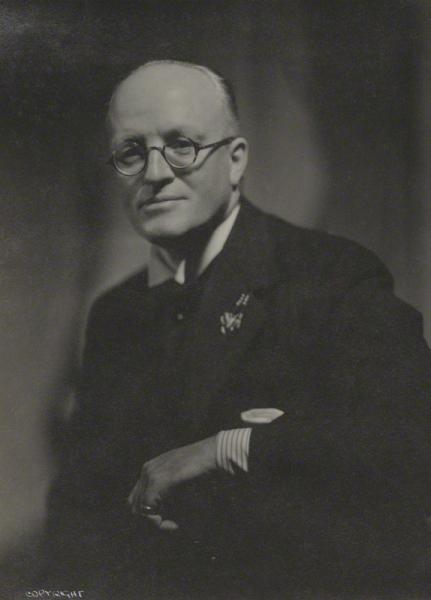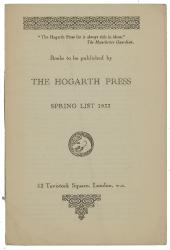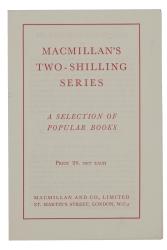Hugh Walpole
Biography
Authored By: Nicholas Redman
Edited By: Illusha Nokhrin
Hugh Seymour Walpole was born on 13 March 1884 in Parnell, a suburb of Auckland, New Zealand. His father was the Revd George Henry Somerset Walpole, the first Precentor of Truro Cathedral. His mother was Mildred Helen Barham, daughter of Dr Charles Barham, the leading physician in Truro. They were married in Truro Cathedral in 1882, sailing shortly afterwards for New Zealand where Walpole had accepted the incumbency of St Mary’s church in Parnell. In 1889 Somerset accepted a new post in New York, and the whole family sailed for England before moving to the States. In 1893 Hugh was sent back to England to a boarding school in Marlow where his unhappy school experiences profoundly influenced his whole life. Later when his father returned from America, Hugh was sent to the King’s School Canterbury from September 1896 until Easter 1898, when he was moved to Durham College (his father, Somerset, was Principal of Bede College, Durham 1896-1903). Walpole wrote later: “I disliked my childhood and everything about it, so that I was delighted to find myself coming of age as an undergraduate of Cambridge”. After three years at Emmanuel College studying history, he was upset to get only a third-class degree. Cambridge is the backdrop to his 1912 novel The Prelude to Adventure.
After university, the expectation of his father was that Hugh would enter the ministry. Despite a growing lack of enthusiasm for the idea, Hugh did spend six months in 1906 as lay minister at the Mersey Mission to Seamen in Liverpool, but soon realised that it was not for him and that he wanted to be a writer. In 1907 he was tutor for four months in Germany to the children of Elizabeth von Arnim, of Elizabeth and her German Garden (1898) fame, then travelled around Germany for a while before returning to England and spending a year as schoolmaster at Epsom College in Surrey. “I was a bad schoolmaster for a short while”, he recalled later. His experiences there later informed his 1911 novel Mr. Perrin and Mr. Traill. Moving to London, he worked briefly part-time at literary agents Curtis Brown and wrote book reviews for the London Standard; in 1909 publishing his first novel The Wooden Horse. He became friendly with Arnold Bennett, Henry James, and Joseph Conrad. Later, as a bestselling writer, he established many important friendships within ‘Bloomsbury’, including with Virginia and Leonard Woolf, Vita Sackville-West, Vanessa Bell, William Plomer, and Duncan Grant.
During the First World War Hugh served in Russia in the Ninth Russian Army with the Red Cross, and, after rescuing a wounded soldier, he was awarded the Cross of Saint George. In 1916 he was appointed a King’s Messenger, and that year made no fewer than four trips to Russia and back. Later he was appointed head of the Anglo-Russian Propaganda Bureau in Petrograd (St Petersburg). Hugh was in Russia during the first 1917 revolution, and his experiences in Russia led to two novels, The Dark Forest (1915) and The Secret City (1919), both largely based on diaries he kept at the time. In 1920 the latter won the James Tait Black Memorial Prize for the best work of fiction published in 1919. In 1918 he took up a post in the Russian Section of the Ministry of Information in London. He was awarded the C.B.E. in the 1918 New Year Honours.
After the war he took rooms at 90 Piccadilly in London, and this remained his London home until his death in 1941. In 1923 he bought a house, Brackenburn (which he later greatly extended), on the slopes of Cat Bells, above Lake Derwentwater in Cumberland, moving in the following year. The area formed the inspiration and the backdrop for three of the four novels in which he charts the lives of the Herries family from the eighteenth century to the present day: Rogue Herries (1930), Judith Paris (1931), The Fortress (1932), and Vanessa (1933), all later collected into a single volume The Herries Chronicle (1939).
Hugh Walpole was a prolific writer, producing thirty-four novels, usually at the rate of at least one book a year. His varied output included London novels, scenes from provincial life, fantasies, stories for children, and macabres. He also wrote over 100 short stories, numerous articles and radio broadcasts on literature, book reviews, and over fifty introductions, prefaces and forewords to other people’s books, as well as five plays, and critical studies of Joseph Conrad and Anthony Trollope. His knowledge of literature and his love of books was immense, as was his own collection of books and literary manuscripts (Many of these manuscripts were donated by Hugh to the King’s School Canterbury before his death. After his death, the extensive remainder of his book and manuscript collection was auctioned by Christie’s). He was a founding member in 1921 of the Society of Bookmen and its first president, and in 1929 was the first chairman of the Book Society. He undertook five extensive lecture tours of the United States (October 1919-March 1920, October 1922-May 1923, October 1926-April 1927, January-March 1930, and November-December 1936), which proved to be very successful and lucrative. He worked in Hollywood in 1934, and again in 1935-36, writing scenarios for Metro-Goldwyn-Mayer and United Artists for four films, in one of which, David Copperfield (1935), he played a cameo part. In 1937, he was knighted for services to literature.
Hugh’s considerable income meant that he was able to indulge not only in buying rare and fine books, but he was also a keen and discerning collector of art. Sir Kenneth Clark called him “one of three or four real patrons of art in this country and of that small body he was perhaps the most generous and the most discriminating”. He owned several paintings by Duncan Grant, including one of Vanessa Bell. The scale of the encouragement and financial help he gave, usually secretly, to younger writers, only began to be fully apparent after his death. T. S. Eliot’s tribute to him in The Times, for example, mentions Walpole’s being ‘quick to appreciate the work of younger men, and ready to help and testify to his belief in their future.’ Hugh died on 1 June 1941 at Brackenburn, aged 57 – his long-term companion, Harold Cheever, by his side – and was buried in the churchyard of St John’s, in Keswick. After the war his work was seen as dated and his popularity rapidly declined and has never really recovered. Only the four novels of the Herries Chronicle have consistently remained in print, although other titles, notably Mr. Perrin and Mr. Traill and Portrait of a Man with Red Hair, have occasionally appeared in paperback.
Walpole’s first two novels, The Wooden Horse (1909) and Maradick at Forty (1910), were both published by Smith, Elder. (An edition of The Wooden Horse appeared in J.M. Dent’s Wayfarer’s Library in 1914). His next two books, Mr. Perrin and Mr. Traill (1911) and The Prelude to Adventure (1912), were published by Mills & Boon. For the following two, Fortitude (1913) and The Duchess of Wrexe (1914), Walpole turned to Martin Secker. In 1915 Cassell published The Golden Scarecrow, and soon afterwards a deal was signed for what would become Jeremy (1919), Jeremy and Hamlet (1923), and Jeremy at Crale (1927). Walpole returned to Martin Secker for The Dark Forest (1916). In 1916, Nisbet and Co published Joseph Conrad. In 1928 Ernest Benn Ltd. published the pamphlet My Religious Experience.
In 1918 Macmillan published The Green Mirror, and thereafter they handled all his work (except the Cassell Jeremy books mentioned above and The Thirteen Travellers published by Hutchinson in 1921). The rights to these books, and those published up to 1916 by other publishers were gradually transferred to Macmillan until 1931, when they held the rights to all Walpole’s main books. Any publication or reissue by others, such as, for instance, the Daily Express Fiction Library (Portrait of a Man with Red Hair), J.M. Dent’s Everyman’s Library (Mr. Perrin and Mr. Traill), Thomas Nelson (The Dark Forest), Oxford University Press (The Prelude to Adventure), Rupert Hart-Davis (The Old Ladies), or Constable & Co (Above the Dark Circus), was by agreement with Macmillan.
The special limited editions of his memoirs, The Crystal Box (1924) and Extracts from a Diary (1934), were printed for Walpole by Robert MacLehose at Glasgow University Press. The Apple Trees (1932) – also autobiographical – was printed by The Golden Cockerel Press. In 1932 the Hogarth Press published Walpole’s A Letter to a Modern Novelist, No. 9 in the Hogarth Letters series: a direct response to Woolf and Walpole’s frequent tea-party debates on reality and the modern novel.
Penguin published Mr. Perrin and Mr. Traill in paperback in 1938, followed by The Dark Forest and The Secret City in 1943. After the Second World War, Pan Books (run by Alan Bott, Walpole’s old friend from the Book Society) republished several titles. Recent years have seen the publication of a number of titles, mostly in paperback, by, for instance, St Martin’s Library, Boydell & Brewer, Frances Lincoln, Capuchin Classics, and Valancourt Press. At least ten titles were published by Tauchnitz for the English-speaking international market. Walpole’s American publisher was George H. Doran, and then Doubleday.
Macmillan issued Walpole’s works in several formats, the familiar green ribbed cloth, the pocket editions in both blue and red covers. Most of the books were also issued in a special large-paper edition, signed and limited, starting with The Cathedral (250 copies) in September 1922. In 1934 Macmillan published a new edition of his collected works, called the Cumberland Edition, of twenty-five books, each with a new preface written by Walpole. Several titles appeared in Macmillan’s Cottage Library. Two titles were published posthumously, The Killer and the Slain (1942), and Mr. Huffam and Other Stories (1948).
Walpole was extremely well connected in the publishing world and established important friendships with Robert Giddings at Golden Cockerel Press, with T. S. Eliot at Faber & Faber and The Criterion, and with the Woolfs at the Hogarth Press. As an author, he was business-savvy and heavily involved in the marketing of his books through multiple editions. His frequent correspondence with Macmillan (now held in the British Library) shows that he was shrewd in keeping his books before the public through new editions. His work with the Book Society as chair of the selection committee between 1929 until his death meant that he was deeply involved in the book trade, with huge knowledge of the book-buying public.
Bibliography
Hugh Walpole Society https://hughwalpole.org
Gordon, Parker T. ""Opposite Ends of the Bloody Stick": Virginia Woolf and Hugh Walpole, Intersections of the Highbrow and Middlebrow." ELH, vol. 89 no. 4, 2022, p. 1107-1134. Project MUSE, doi:10.1353/elh.2022.0038.
Rupert Hart-Davis, Hugh Walpole (1952; 1985)
Alexis Weedon and Giannandrea Poesio, ‘The Origins of the Broadbrow: Hugh Walpole and Russian Modernism in 1917’ TF_Template_Word_Mac_2011 (openrepository.com)
Wilson, Nicola. “Virginia Woolf, Hugh Walpole, The Hogarth Press, and the Book Society.” ELH, vol. 79, no. 1, 2012, pp. 237–60. JSTOR, http://www.jstor.org/stable/41337586. Accessed 11 May 2023.










